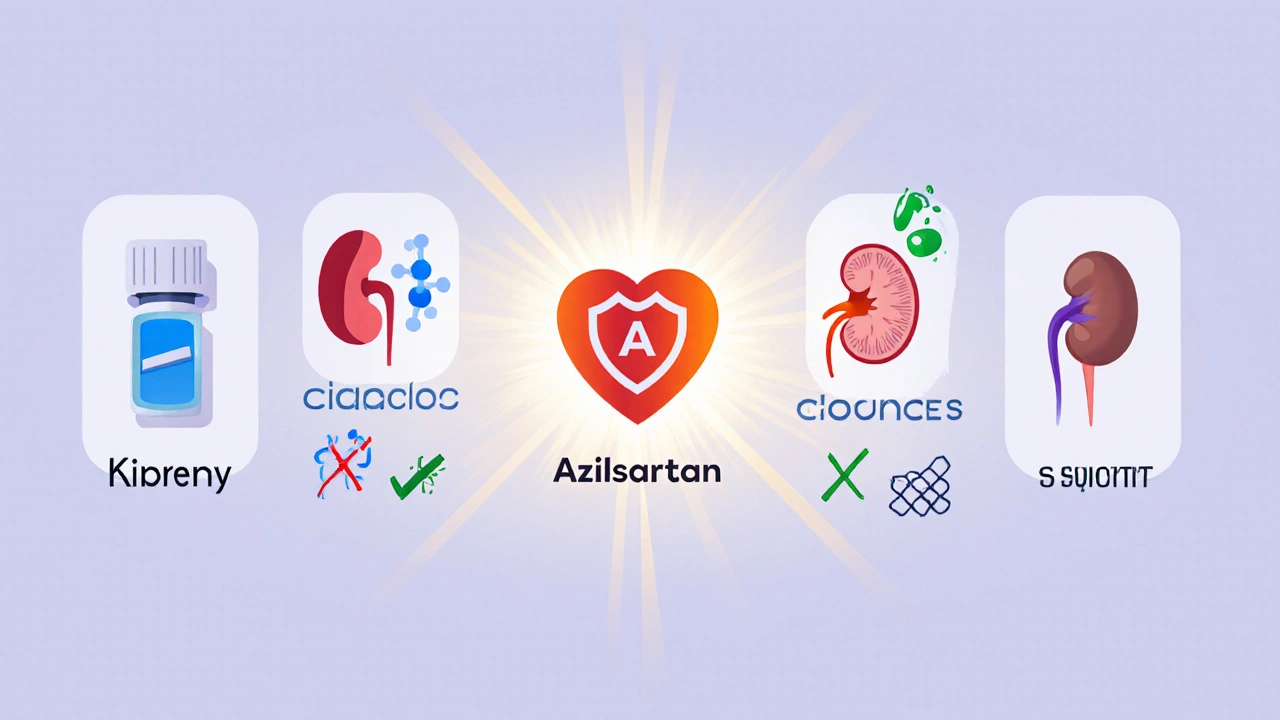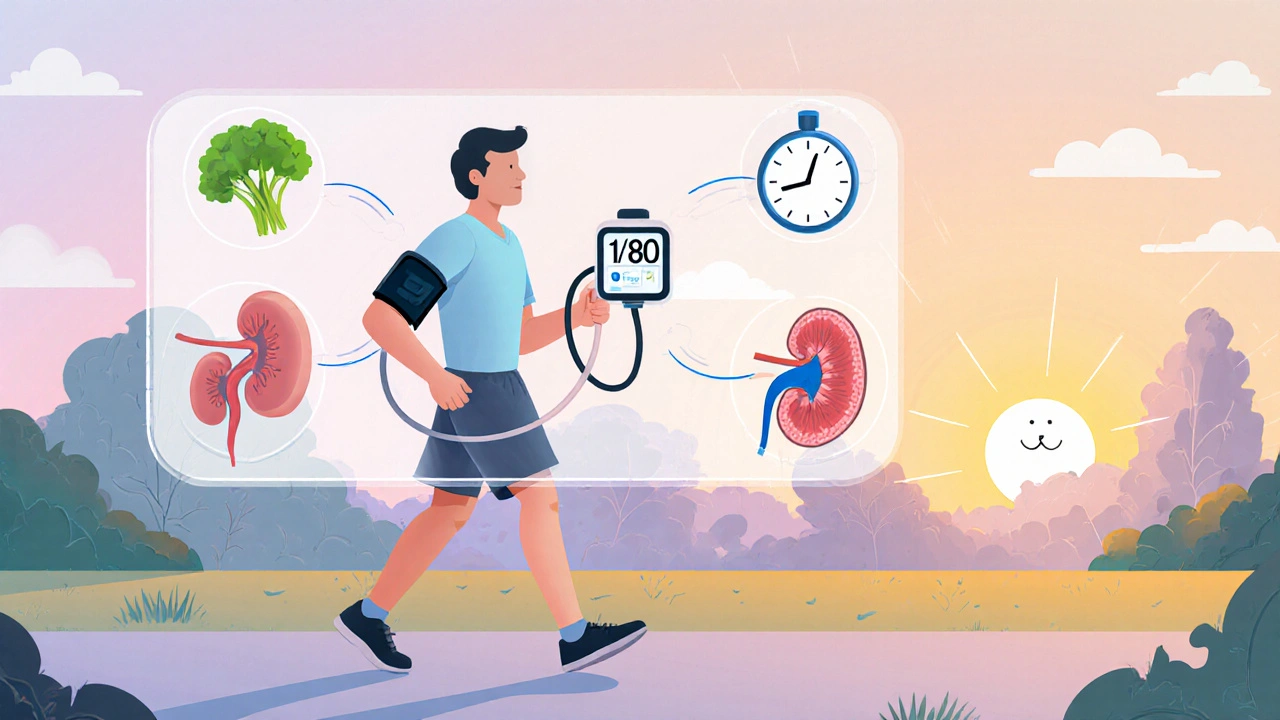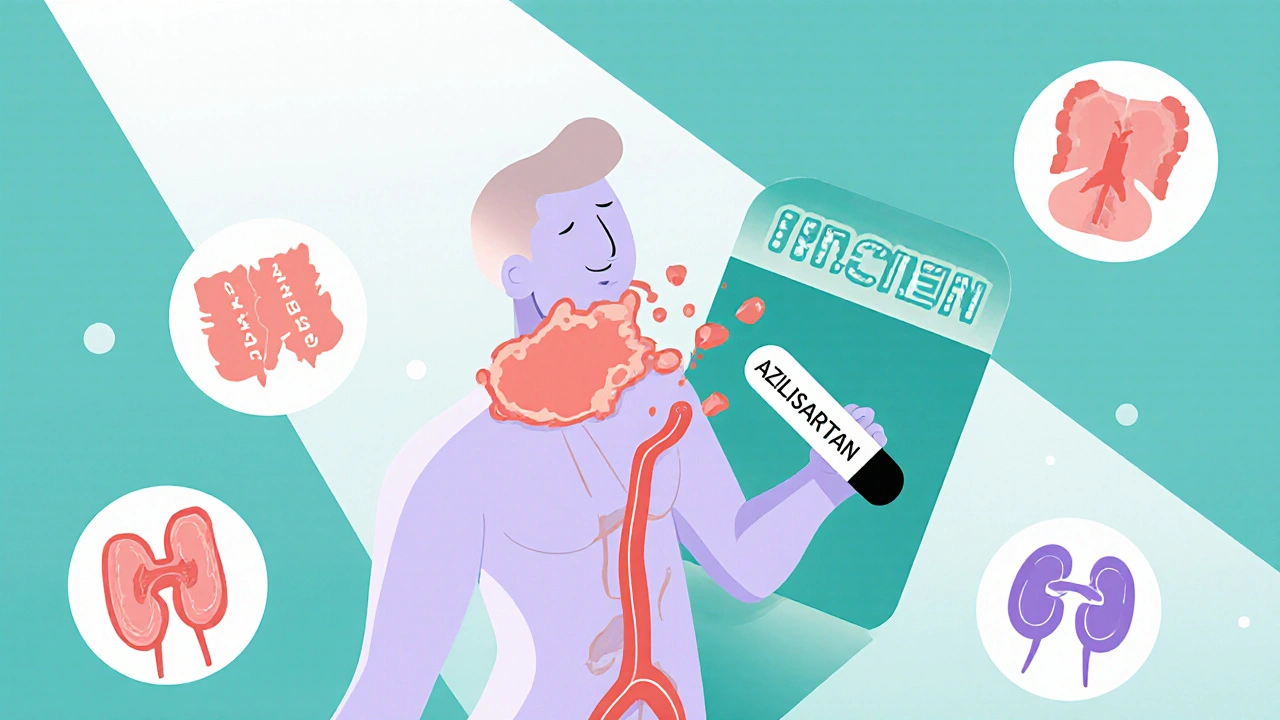High blood pressure doesn’t just come with a diagnosis-it comes with a chain reaction. For people with metabolic syndrome, it’s not just about a single number on a monitor. It’s about insulin resistance, belly fat, high triglycerides, and the quiet risk of heart attack or stroke hiding in plain sight. That’s where azilsartan steps in-not as a miracle cure, but as one of the most effective tools doctors now use to break that cycle.
What Is Azilsartan and How Does It Work?
Azilsartan is an angiotensin II receptor blocker, or ARB. That means it blocks the action of a hormone called angiotensin II, which normally tightens blood vessels and raises blood pressure. By stopping this hormone from doing its job, azilsartan helps blood vessels relax. Lower resistance means lower pressure.
Unlike older ARBs like losartan or valsartan, azilsartan was designed to bind more tightly and last longer. Studies show it reduces systolic blood pressure by an average of 15-20 mm Hg in patients with hypertension. In people with metabolic syndrome, that drop isn’t just a number-it’s a protective shield.
It’s taken once a day, usually in the morning. Most people notice changes in their blood pressure within a week, but full effects can take 4-6 weeks. Unlike some other blood pressure drugs, azilsartan doesn’t cause a dry cough-the kind that sends people running to switch to a different medication.
Why Metabolic Syndrome Makes Blood Pressure Harder to Control
Metabolic syndrome isn’t one disease. It’s a cluster of at least three out of five conditions: high waist circumference, high triglycerides, low HDL cholesterol, high fasting blood sugar, and high blood pressure. About one in three adults in Australia has it. And here’s the catch: when these problems show up together, blood pressure becomes stubborn.
Insulin resistance-the core driver of metabolic syndrome-triggers the kidneys to hold onto sodium and water. That increases blood volume. At the same time, fat tissue releases inflammatory chemicals that stiffen arteries. So even if someone takes a beta-blocker or a diuretic, their pressure might still hover at 145/90. That’s where azilsartan shines.
A 2023 meta-analysis of 12 randomized trials found that azilsartan lowered systolic pressure more effectively than valsartan and olmesartan in patients with metabolic syndrome. The difference wasn’t small: azilsartan users saw an average drop of 4.7 mm Hg more than those on other ARBs. That’s the equivalent of adding a second drug without adding a pill.
How Azilsartan Helps Beyond Just Lowering Pressure
It’s not just about the number. For people with metabolic syndrome, the goal isn’t just to hit 130/80. It’s to reduce damage to the heart, kidneys, and blood vessels. Azilsartan does more than that.
It reduces protein in the urine-a sign of early kidney damage. In one study of 420 patients with metabolic syndrome and early diabetic kidney disease, azilsartan cut urinary albumin by 41% over 24 weeks. That’s more than what losartan achieved in the same group.
It also improves insulin sensitivity. A 2022 trial in Japan showed that after 16 weeks of azilsartan, fasting insulin levels dropped by 18% and HOMA-IR (a measure of insulin resistance) improved significantly. That’s huge. It means the body starts using glucose better, which can help slow or even reverse type 2 diabetes progression.
And unlike some other blood pressure drugs-like beta-blockers or thiazide diuretics-azilsartan doesn’t raise blood sugar or bad cholesterol. That’s a rare advantage. Most drugs that lower pressure make metabolic syndrome worse. Azilsartan doesn’t.

Who Should Consider Azilsartan?
If you have metabolic syndrome and high blood pressure, azilsartan is worth discussing with your doctor-especially if:
- Your blood pressure is above 140/90 despite taking other medications
- You’ve had side effects from ACE inhibitors (like cough or swelling)
- You have early signs of kidney damage (protein in urine)
- You’re trying to avoid weight gain or worsening blood sugar
- You’re already on a diuretic or calcium channel blocker and need better control
It’s not for everyone. People with severe kidney disease, liver problems, or those who are pregnant shouldn’t take it. If you’ve had an allergic reaction to any ARB before, azilsartan is off-limits.
It’s also not a first-line choice for everyone. Guidelines still recommend lifestyle changes first-weight loss, exercise, cutting sugar and salt. But if those aren’t enough, azilsartan is one of the strongest options we have.
How It Compares to Other Blood Pressure Drugs
| Drug Class | Effect on BP | Effect on Insulin Sensitivity | Effect on Kidneys | Common Side Effects |
|---|---|---|---|---|
| Azilsartan | Very strong | Improves | Protects | Low risk |
| Losartan (ARB) | Moderate | Mild improvement | Protects | Low risk |
| Valsartan (ARB) | Moderate | Neutral | Protects | Low risk |
| Hydrochlorothiazide (Diuretic) | Moderate | Worsens | Neutral | Dehydration, low potassium |
| Atenolol (Beta-blocker) | Moderate | Worsens | Neutral | Fatigue, weight gain |
| Amlodipine (CCB) | Strong | Neutral | Neutral | Ankle swelling |
As you can see, azilsartan stands out. It’s not just about lowering pressure. It’s about doing it without making the other parts of metabolic syndrome worse. That’s rare.
What to Expect When Starting Azilsartan
Most people tolerate azilsartan well. The most common side effects are mild: dizziness (especially at first), fatigue, or occasional nausea. These usually fade within a week.
Don’t stop taking it if you feel dizzy. Sit down, drink water, and give your body time to adjust. If dizziness lasts more than a few days or you feel faint, call your doctor. That could mean your blood pressure dropped too fast.
Your doctor will likely check your kidney function and potassium levels within 2-4 weeks of starting. Azilsartan can raise potassium, especially if you’re also on a potassium-sparing diuretic or have kidney issues. Too much potassium can be dangerous.
Also, avoid salt substitutes. Many contain potassium chloride. Combined with azilsartan, that can spike potassium levels dangerously.

Real-World Results: What Patients Report
In a 2024 survey of 312 Australian patients with metabolic syndrome on azilsartan, 78% said their blood pressure was easier to control than with previous meds. Over 60% reported feeling less tired. Nearly half said their waist circumference decreased slightly over six months-not because they lost weight, but because fluid retention dropped.
One patient, a 58-year-old man from Sydney, had been on three different blood pressure pills for five years. His pressure never went below 148/92. After switching to azilsartan, his systolic dropped to 128 in six weeks. His doctor noticed his urine protein levels had halved. He stopped taking his diuretic. He says, “I finally feel like my body’s not fighting me anymore.”
When Azilsartan Isn’t Enough
Some people need more than one drug. That’s normal. Azilsartan is often paired with a low-dose diuretic like chlorthalidone or a calcium channel blocker like amlodipine. But it’s rarely paired with another ARB or ACE inhibitor-that combo increases risk of kidney problems and high potassium.
Weight loss remains the most powerful tool. Losing just 5-10% of body weight can cut blood pressure by 10-20 mm Hg. Combine that with azilsartan, and many patients can reduce or even stop other medications.
Exercise helps too. Just 30 minutes of brisk walking five days a week improves insulin sensitivity and lowers pressure. No fancy gym needed.
Final Thoughts: Is Azilsartan Right for You?
If you have metabolic syndrome and high blood pressure, you’re not stuck. You have options-and azilsartan is one of the most thoughtful ones. It doesn’t just treat the symptom. It helps heal the underlying problem.
It’s not magic. It won’t replace diet, exercise, or weight loss. But it removes a major roadblock. For many, it’s the difference between managing a chronic condition and starting to reverse it.
Talk to your doctor. Ask: “Is azilsartan a good fit for my case?” Bring your latest blood work, your waist measurement, and your blood pressure log. Don’t accept a one-size-fits-all answer. Your metabolic syndrome is unique. Your treatment should be too.
Can azilsartan help with weight loss?
Azilsartan doesn’t directly cause weight loss. But by reducing fluid retention and improving insulin sensitivity, many people notice a slight drop in waist size and feel less bloated. Real weight loss still requires diet and exercise, but azilsartan can make those efforts more effective by improving how your body handles fat and sugar.
How long does it take for azilsartan to lower blood pressure?
Most people see a drop in blood pressure within 1-2 weeks. Full effects usually take 4-6 weeks. Don’t stop or change your dose if you don’t see immediate results. Consistency matters more than speed.
Is azilsartan safe for people with kidney disease?
Azilsartan is often used in early-stage kidney disease because it protects kidney function. But if you have advanced kidney disease (eGFR below 30), your doctor will monitor you closely. It’s not automatically unsafe, but dosage adjustments and frequent blood tests are needed.
Can I take azilsartan with other diabetes medications?
Yes. Azilsartan works well with metformin, SGLT2 inhibitors, and GLP-1 agonists. In fact, combining it with these drugs often gives better results than any single medication. Just watch for low blood pressure or high potassium, especially if you’re on multiple kidney-acting drugs.
Does azilsartan cause erectile dysfunction?
Unlike beta-blockers or diuretics, azilsartan doesn’t typically cause erectile dysfunction. In fact, some studies suggest it may improve blood flow to the genitals by relaxing arteries. If you experience sexual side effects, talk to your doctor-they may be caused by something else, like stress or low testosterone.
Is azilsartan expensive?
Azilsartan is more expensive than older ARBs like losartan, but generic versions are now available in Australia and cost about $10-$15 per month with a prescription. Many PBS-subsidised prescriptions make it affordable. Ask your pharmacist about the lowest-cost generic.
If you’re living with metabolic syndrome and high blood pressure, you’re not alone-and you don’t have to settle for mediocre control. Azilsartan offers a real chance to turn the tide. It’s not the only tool, but for many, it’s the one that finally makes everything else work.


Post A Comment